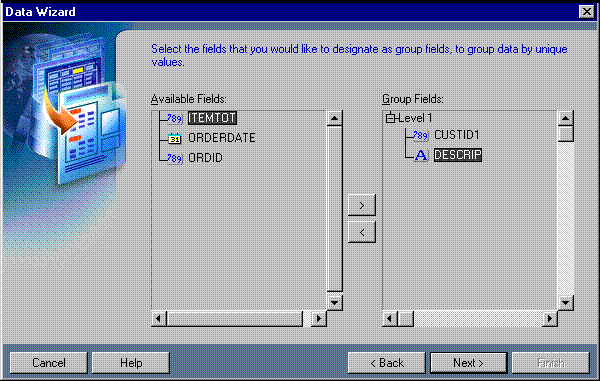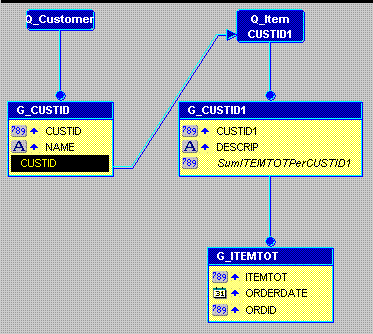13.3 Create a Data Model with a Data Link
When you create a report with multiple queries, it is typically easier to create all of the queries with the Data Wizard first and then create the layouts with the Report Wizard.
-
In the Data Model view, choose Insert > Query to display the Data Wizard.
-
If the Welcome page displays, click Next.
-
On the Query page, type
Q_Customerfor the Query name, then click Next. -
On the Data Source page, select SQL Query, then click Next.
-
On the Data page, enter the following
SELECTstatement in the Data Source definition field:SELECT CUSTID, NAME FROM CUSTOMER ORDER BY NAME
Note:
You can enter this query in any of the following ways:-
Copy and paste the code from the provided text file called
grp_above_summ_code.txtinto the Data Source definition field. -
Click Query Builder to build the query without entering any code manually.
-
Type the code in the Data Source definition field.
-
-
Click Next.
Note:
If you are not already connected to a database, you will be prompted to connect to the database when you click Query Builder or Next. Ensure that you connect to a database that has the appropriate schema for this example. Section 13.1, "Prerequisites for This Example" describes the sample schema requirements for this example. -
On the Groups page, click Next.
-
Click Finish to display your first query in the Data Model view.
-
Repeat the steps above for a second query, but this time name your query
Q_Itemand use the followingSELECTstatement:SELECT CUSTID, DESCRIP, ITEMTOT, ORDERDATE, ITEM.ORDID FROM ORD, PRODUCT, ITEM WHERE ITEM.ORDID = ORD.ORDID AND ITEM.PRODID = PRODUCT.PRODID ORDER BY CUSTID, DESCRIP, ORDERDATE
-
On the Groups page of the Data Wizard:
-
Click CUSTID1 and click the right arrow (>) to move this field to the Group Fields list.
-
Do the same for DESCRIP.
Figure 13-2 Groups page of the Data Wizard

Description of ''Figure 13-2 Groups page of the Data Wizard''
-
-
Click Next.
-
On the Totals page, click ITEMTOT and click Sum.
-
Click Finish to display the data model for your report in the Data Model view. It should look something like this:
Figure 13-3 Two-query data model with summaries

Description of ''Figure 13-3 Two-query data model with summaries''
-
In the Data Model view, click the Data Link tool in the tool palette.
-
Click and drag from the CUSTID column in the G_CUSTID group to the CUSTID1 column in the G_CUSTID1 group. Notice that a line is drawn from the bottom of the G_CUSTID group to the Q_Item query. Labels for CUSTID and CUSTID1 are created at each end of the line to indicate they are the columns linking G_CUSTID to Q_Item.
Figure 13-4 Two-query data model with a data link

Description of ''Figure 13-4 Two-query data model with a data link''
-
Double-click the new data link line to display the Property Inspector and examine the property settings:
-
G_CUSTID is identified as the parent, while Q_Item is listed as the child. In terms of the data, the customer's identifier and name make up the master record and should print once for the associated item order information retrieved by the Q_Item query.
-
Notice that WHERE already appears in the SQL Clause property. WHERE is the default clause used in master/detail relationships. You can replace WHERE with other SQL clauses such as HAVING and START WITH, but for this report the default is correct.
-
The other point to notice is that an equal sign (=) appears in the Condition property. An equality (that is, table1.columnname = table2.columnname) is the default condition for master/detail relationships defined through a data link. You can replace the equal sign with any other supported conditional operator (to see what is supported, click the field), but for this report the default is the proper condition.
-